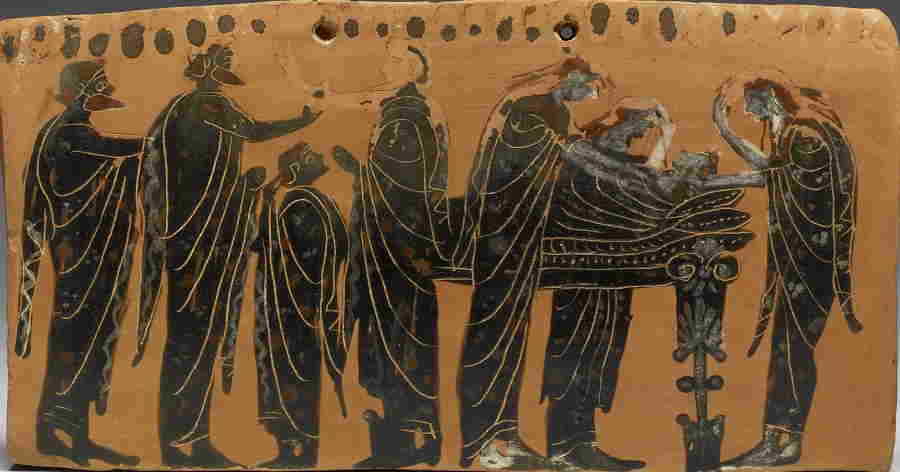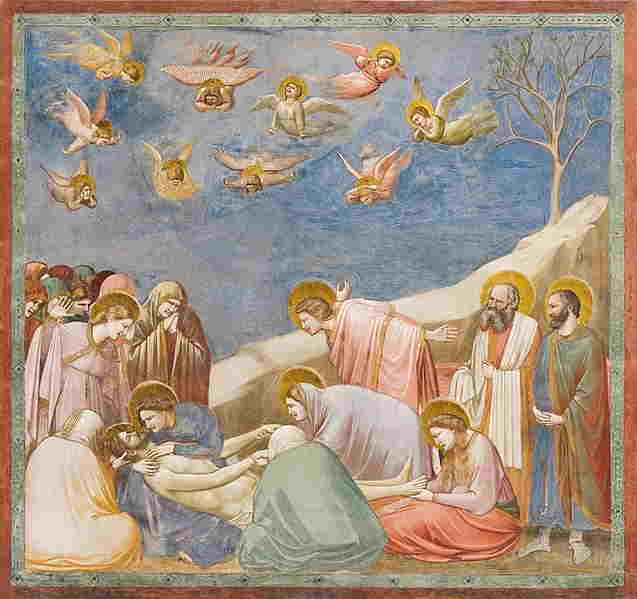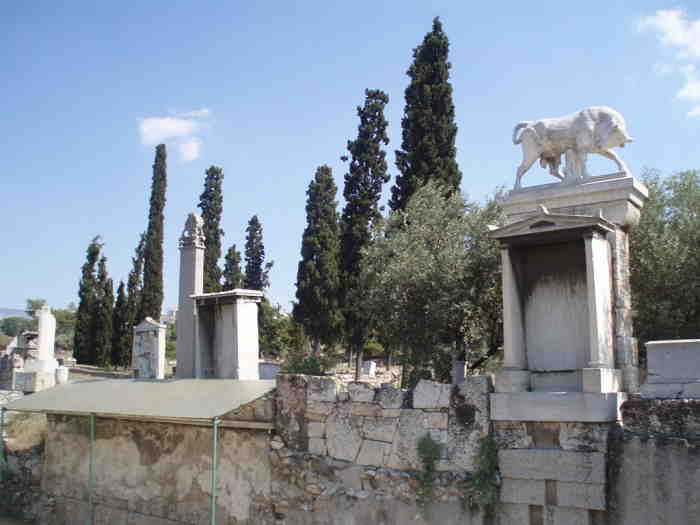

he ancient Greek "prothesis" was a significant and solemn ritual in their burial practices. It involved the laying out of the deceased's body at their home, typically on a bier or a funeral bed. This ritual was the initial step in the process of preparing the deceased for their journey to the afterlife.
During the prothesis, family members, friends, and even professional mourners would gather in the deceased person's home to pay their respects and mourn their passing. The body was carefully washed, anointed with oils and perfumes, and dressed in burial attire. Personal belongings and symbolic items might be placed alongside the body.
The prothesis served not only as a means to prepare the body but also as an opportunity for loved ones to express their grief and share memories. It allowed for a final farewell in a familiar and comforting setting before the actual funeral or cremation took place.
This ritual underscored the importance of honoring the deceased and facilitating their transition to the afterlife, reflecting the Greeks' strong beliefs in the significance of proper burial and remembrance.
In ancient Greek burial practices, the clothing of the deceased was an important aspect of preparing the body for burial or cremation. The choice of clothing varied depending on factors such as social status and regional customs, but some common elements were:
Tunic or Chiton: The deceased would often be dressed in a simple tunic or chiton, which was a loose-fitting garment made of wool or linen. The style and color might differ based on gender and social standing.
Burial Shroud: In some cases, especially for women, a burial shroud might be used instead of a tunic. This shroud could be plain or adorned with decorative elements.
Sandals: The deceased's feet were often covered with sandals or shoes appropriate to their status.
Jewelry and Personal Items: Depending on the deceased's social standing, jewelry, personal items, and sometimes even coins might be placed with the body.
Wreaths and Crowns: Funerary wreaths or crowns made of leaves, flowers, or other materials might be placed on the head of the deceased as a symbol of honor and remembrance.
Amulets and Tokens: Sometimes, protective amulets or tokens with religious or symbolic significance were included in the burial attire.
The specific clothing choices and customs could vary across different Greek city-states and time periods. However, the overall aim was to provide the deceased with a dignified and respectful appearance for their journey to the afterlife, while also acknowledging their status and achievements in life.

The Lamentation, also known as the "threnos" in ancient Greek, was a deeply ingrained part of Greek funeral rituals and mourning practices. It involved mourners, often including professional female lamenters called "threnodes," expressing their grief and sorrow for the deceased through mournful songs, chants, and gestures.
Key aspects of the Lamentation in ancient Greece included:
Lamentation Choruses: A group of mourners, primarily women, would gather to form a chorus. They would sing and chant sorrowful verses, often accompanied by music from instruments like the aulos (double-reeded flute).
Poetic Expression: The lamenters would recite or sing poetic verses that praised the deceased, recounted their virtues, and expressed the pain of loss. These verses were often improvised or followed established poetic forms.
Gestures and Movements: Lamenters would engage in physical expressions of grief, such as tearing their hair, beating their chests, and engaging in dramatic movements.
Funeral Processions: Lamentation was an integral part of the funeral procession. Mourners would accompany the deceased's body to the burial site while performing their lamentations.
Catharsis: The Lamentation served as a cathartic release of grief, allowing mourners to openly express their emotions and share their sorrow with the community.
Mythological and Religious Themes: Laments often referenced mythological and religious themes, connecting the deceased to the divine and the afterlife.
The Lamentation was not only a form of mourning but also a means of honoring the deceased and helping them transition to the afterlife. It was a significant cultural and emotional expression in ancient Greek society, reflecting the importance of grief and remembrance in their funeral customs.
In ancient Greek funeral customs, the "Ekphora" was a crucial and solemn ritual that formed part of the overall funeral procession. It specifically referred to the process of transporting the deceased's body from the home or the place of preparation to the burial site or cremation ground.
Key elements of the Ekphora included:
Funeral Procession: The Ekphora was an integral part of the funeral procession, which involved family members, friends, and mourners accompanying the deceased's body to its final resting place.
Preparation of the Body: Prior to the Ekphora, the deceased's body would be prepared, typically with washing, anointing, and dressing in appropriate burial attire.
Transportation: The body would then be placed on a bier or a funeral bed, often decorated with flowers or other symbolic items. In some cases, the body might be carried in a coffin.
Mourners and Lamentation: Mourners, including professional lamenters called "threnodes," would participate in the Ekphora. They would express their grief through lamentations, songs, and gestures.
Route and Destination: The funeral procession followed a specific route to reach the burial or cremation site, which might be a cemetery, a family tomb, or a designated area. The destination held cultural and religious significance.
Religious Observances: Depending on the individual's beliefs and the regional customs, there might be religious rituals or offerings conducted during the Ekphora.
Final Rites: The Ekphora culminated with the burial or cremation of the deceased, accompanied by additional religious rites or ceremonies.
The Ekphora served several purposes, including providing an opportunity for loved ones to pay their respects and bid farewell, expressing grief, and facilitating the deceased's transition to the afterlife. It was a communal event that underscored the importance of proper burial and remembrance in ancient Greek culture.
In ancient Greek funeral customs, "The Deposition" was a crucial step in the burial or cremation process. It referred to the act of placing the deceased's body in its final resting place, often a tomb, grave, or on the funeral pyre.
Key elements of The Deposition included:
Burial or Cremation: Depending on regional customs and personal beliefs, the body was either buried in a grave or tomb or placed on a funeral pyre for cremation.
Preparation: Before The Deposition, the body underwent preparation, which included washing, anointing with oils and perfumes, and dressing in burial attire.
Placement: In the case of burial, the body was carefully placed in the grave or tomb, often wrapped in burial shrouds. If cremation was chosen, the body was positioned on the funeral pyre.
Offerings and Rituals: Depending on religious and cultural practices, offerings, prayers, or religious rituals might accompany The Deposition. These rituals were intended to honor the deceased and ensure a smooth transition to the afterlife.
Tomb or Grave Goods: In some cases, burial tombs or graves were furnished with grave goods, including personal belongings, pottery, or symbolic items, to accompany the deceased.
Covering or Closing: After the placement of the body, the grave or tomb was sealed or covered with earth and stones. In the case of cremation, the pyre was lit, and the body was consumed by fire.
The Deposition marked the final physical act of laying the deceased to rest. It held significant cultural, religious, and emotional importance, emphasizing the ancient Greeks' beliefs in the afterlife and the necessity of proper burial to ensure a peaceful transition for the departed soul.
Ancient Greek burial banquets, often referred to as "funeral feasts" or "symposia," were an integral part of Greek funeral customs and played a vital role in honoring the deceased and providing closure for the bereaved. These banquets combined elements of mourning, celebration, and remembrance.
Key aspects of ancient Greek burial banquets included:
Purpose: Funeral banquets served as a communal gathering where family, friends, and mourners could come together to remember the deceased, express their grief, and offer support to the bereaved.
Location: The location of the banquet varied but was typically held at the deceased's home or a communal space. Wealthier families might host elaborate banquets at their residences.
Food and Drink: Food and wine were central to these gatherings. Offerings often included traditional Greek dishes like bread, olives, cheese, and honey, as well as meat and fish. Wine was a common beverage, and libations were made to honor the deceased.
Eulogies and Lamentations: The banquet provided an opportunity for mourners to share stories, eulogies, and memories of the deceased. Professional mourners called "threnodes" might perform lamentations and songs.
Symbolism: Certain foods and rituals had symbolic significance. For example, eggs and lentils symbolized life and death, and participants often washed their hands as a purifying act.
Entertainment: Music, poetry, and other forms of entertainment were sometimes included to provide solace and diversion for the mourners.
Duration: The duration of the banquet varied but could last for several hours or even days, particularly for prominent individuals or wealthy families.
Community Support: These gatherings not only honored the deceased but also served as a way for the community to offer emotional support to the grieving family.
Conclusion: The banquet concluded with libations and rituals to ensure the deceased's safe passage to the afterlife.
Funeral banquets in ancient Greece were a blend of mourning and celebration, reflecting the belief in the importance of proper burial and remembrance. They provided a way for the community to come together, share their grief, and pay tribute to the departed soul.
In ancient Greek burial practices, cleansing of the deceased played a significant role in the preparation of the body for burial or cremation. This cleansing process, known as "katharsis" in Greek, involved several important steps:
Washing the Body: The first step of cleansing was to wash the deceased's body. Family members or attendants would carefully bathe the body with water and sometimes wine or perfumed oils. This act was not only for hygienic reasons but also had symbolic importance in purifying the deceased.
Anointing with Oils: Following the washing, the body would be anointed with oils and perfumes. These oils often had aromatic properties and were believed to help preserve the body and mask any unpleasant odors.
Dressing in Burial Attire: The deceased would then be dressed in appropriate burial attire. This clothing could vary depending on the individual's gender, social status, and regional customs.
Adorning with Jewelry: In some cases, the deceased might be adorned with jewelry, personal items, or symbolic tokens. These items were often placed on or near the body.
Preparation for the Ekphora: After the cleansing process, the body was prepared for transport in the funeral procession, known as the "Ekphora." The deceased would be placed on a bier, funeral bed, or within a coffin if applicable.
Cleansing in ancient Greek burial practices had both practical and symbolic significance. It aimed to prepare the deceased's body for the journey to the afterlife while also ensuring that the person was treated with respect and dignity. The use of perfumes and oils added an element of ritual purification and helped mask any odors associated with decomposition, reflecting the Greeks' reverence for proper burial and remembrance.

Ancient Greek burial practices were deeply influenced by religious beliefs, and they often revolved around the honor of the deceased and the desire to ensure their peaceful transition to the afterlife. Here's an exploration of some key elements of these practices, including the role of gods, temples, and concerns about pollution:
1. Role of the Gods:
2. Funeral Pyres and Cremation:
3. Temples and Rituals:
4. Concerns about Pollution:
5. Communal and Private Practices:
Ancient Greek burial practices were deeply rooted in religious beliefs and aimed to ensure a peaceful transition to the afterlife. The involvement of gods, temples, purification rituals, and communal expressions of grief all reflected the importance of proper burial and remembrance in Greek culture.